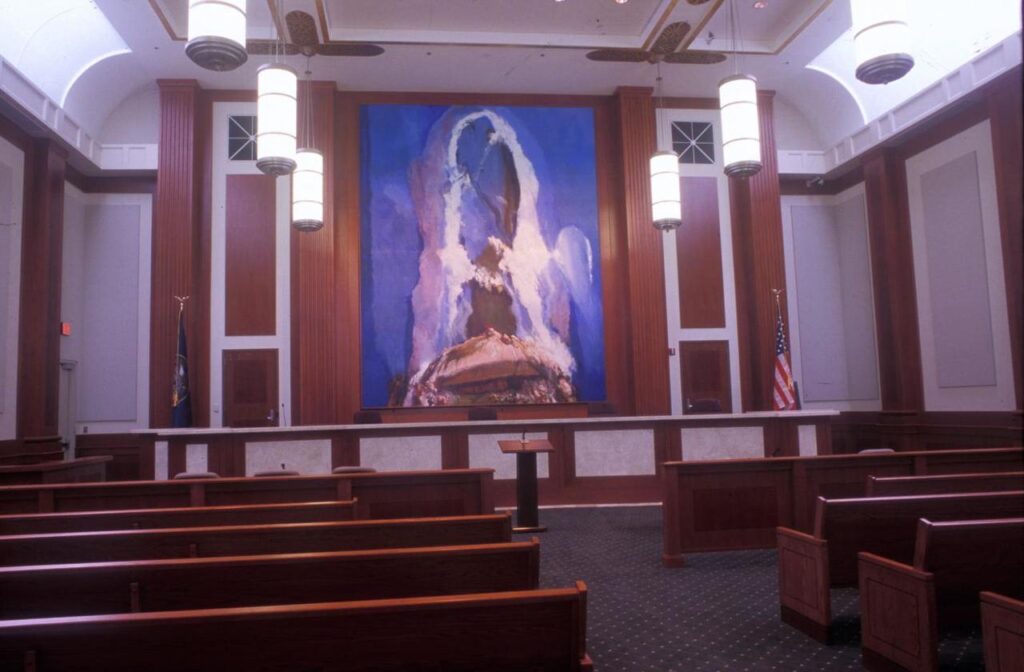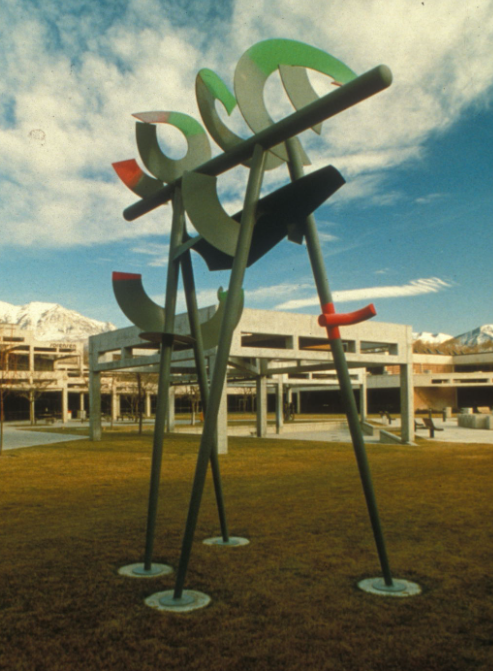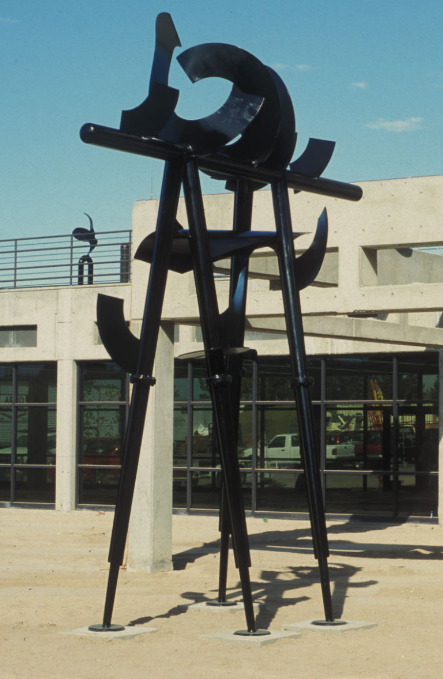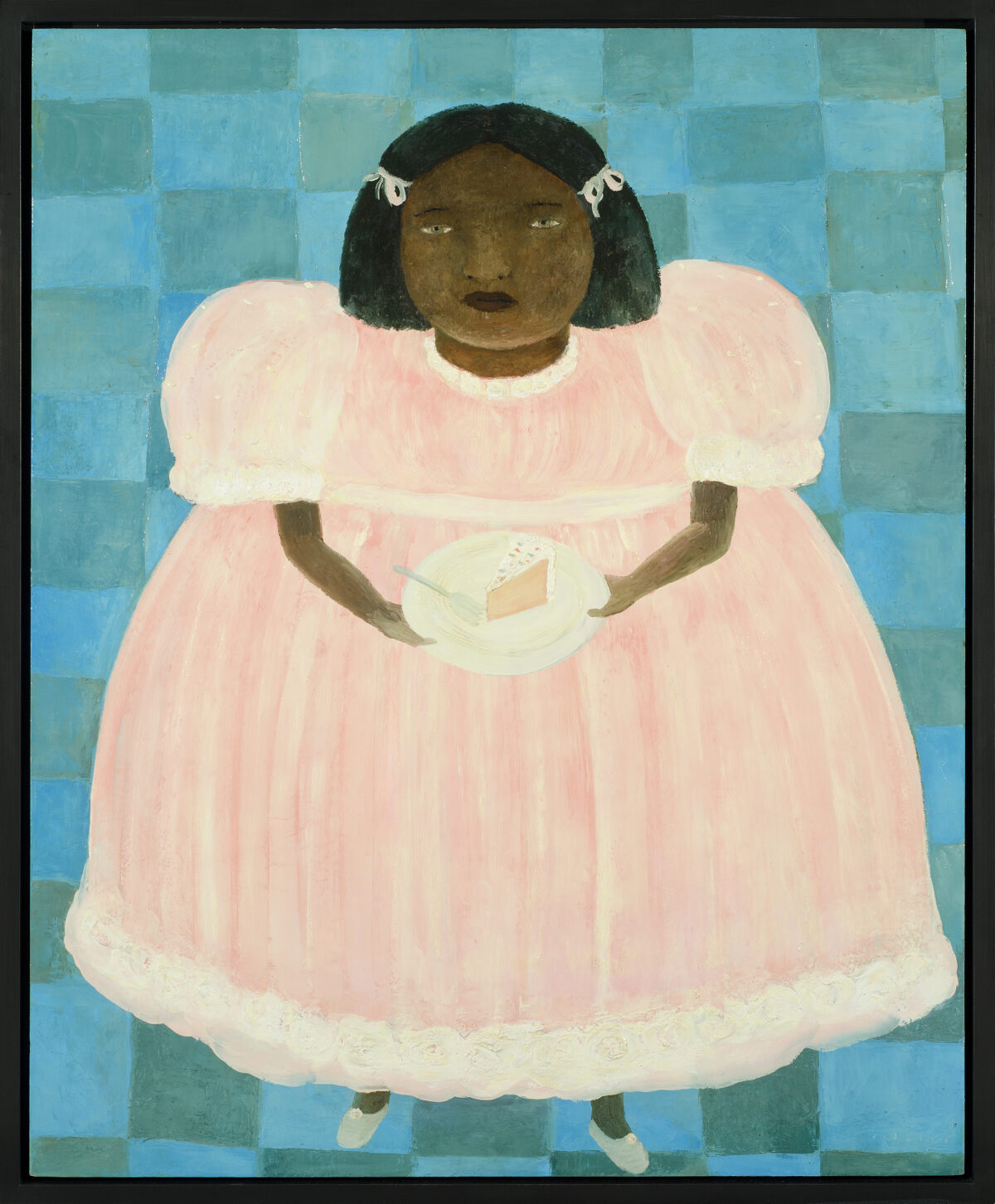We at the Utah Division of Arts & Museums are celebrating our agency’s 125th anniversary in 2024. The division has been acquiring art by Utah artists ever since its founding in 1899, and we’d like to share five highlights from the division’s collection, known as the State of Utah Alice Merrill Horne Art Collection. This collection now includes more than 2,000 works of painting; sculpture; mixed media; folk and traditional art; and public art.
“Sunday Best with Cake” by Fidalis Buehler (1977 – ), 2012, oil on panel
As a result of the earthquake that rocked northern Utah in March of 2020, the racking system in our storage facility was badly damaged. In the first few days following the earthquake, we remained uncertain about the status of the State of Utah Alice Merrill Horne Art Collection and if any pieces had been completely destroyed – thankfully, none were.
During this uncertain time, “Sunday Best with Cake” became a symbol of hope after it was found protecting many of the surrounding artworks with its sturdy frame. “Sunday Best with Cake” now hangs in the third-floor gallery space of the Governor’s Mansion in Salt Lake City.

“Capitol Reef” by V. Douglas Snow (1927 – 2009), 1997, oil on canvas
This 300-square-foot mural depicts Utah’s signature red rock sandstone in the sun after a thunderstorm. “Capitol Reef” was originally installed as part of our Public Art Program’s Percent-for-Art process during the building of the Scott M. Matheson Courthouse in Salt Lake City. When the artwork was first installed, some court officials and lawyers felt it distracted them from court proceedings. In 2001, the courts decided to cover the painting with a gray drape while court was in session. This drape was the compromise reached with the artist when officials realized removing the work was impossible without destroying it.
Happily, in 2023, a decision was made to return the painting to public view. In a story by FOX 13 News in November of that year, the current justices released a joint statement about the painting: “Just as there will inevitably be conflicting views on difficult questions of law, there will always be disagreements over particular pieces of art. We understand that some people like the painting and others do not. Diversity of thought is healthy. To us, the painting represents the ability of individuals to hold differing opinions while still respecting each other and each other’s views. As a community, we must find ways to talk to each other civilly, especially about matters on which we disagree.”


“Untitled (Horse Form)” by Richard Johnston (1942 – 2017), 1991, steel and pigment
Another artwork from our Public Art Program, this sculpture lives at Utah Valley University. Johnston was commissioned after presenting the concept of creating an environment of sculptural pieces at various sites and levels in the main quad area of the campus near the science facility. The colors of the pieces referenced the interior color scheme of the ventilation and heating system. All of the satellite pieces were anchored with the free-standing, whimsical “horse form” at the center of the quad.
Unfortunately, this work was disliked by the university’s then-president, who had it destroyed in 1996. The central artwork has since been restored and re-installed in another location on the UVU campus. The restored piece, all in black, is a more somber and less playful work, reflecting the trauma and stress experienced by the artist after the original artwork’s destruction.

“Killing of the Journalists” by Jeronimo Lozano (1950 – 2021), n.d., clay/wood
Jeronimo Lozano created “Killing of the Journalists” while he was a student in the Fine Arts Program at the University of Lima. During that time, in the early 1980s, a group of Maoist revolutionaries known as The Shining Path began a guerilla war against the Peruvian government. When a group of journalists went to Jeronimo’s hometown of Ayacucho to investigate allegations of brutality, one of his classmates, a journalism student, accompanied them. They investigated a mass killing of indigenous Andean people; it was unclear then, and still is today, whether the murders were committed by the Shining Path or by the military. But those who went to investigate the atrocities never returned to tell the story.
With the unresolved fate of his classmate and the other journalists in mind, Lozano began his own investigation. Dressed as a llama herder, he traveled to Ayachucho and spoke to people in their native Quechua language. He soon learned the depth and complexity of the tragic story as they told him that the bodies of the journalists had been discovered. When he returned to Lima, he created this retablo as his own journalistic expression. The various compartments of the retablo relate the story of the killing of the journalists, scene by scene.
In 1994, Lozano came to Utah while touring with a folkloric dance troupe. Since he had family and friends displaced and killed by the armed struggles in Peru, he feared returning to his homeland. He was granted INS status as an “Artist of Extraordinary Ability” and became a Utah resident. Lozano received a Utah Division of Arts & Museums Visual Arts Fellowship in 1996, the Governor’s Folk Arts Award in 2002, and, in 2008, he received a National Heritage Fellowship from the National Endowment for the Arts, the highest level of achievement in this country for folk artists.
Lozano produced hundreds of retablos while living in Utah, but “Killing of the Journalists” is special. It not only chronicles an event few initially knew about, but it is one of only a handful of artworks that Lozano brought with him to the United States when he left Peru.

“Fish House” by Carole Alden (1960 – ), 2017, crochet fiberwork
In the artist’s own words: “In July of 2006, life was irrevocably altered by an event of extreme domestic violence that culminated in my use of deadly force to preserve my own life and the lives of my children. Without resources for legal representation, I accepted a plea bargain and began a 15-year sentence for manslaughter. Housed at the Utah State Prison, I focused on maintaining my family connection through drawings, and eventually explored crochet as a means to create sculptural forms.
A few years back, I began to contemplate what my living situation might entail, released from 15 years in prison, as a senior citizen, with no resources beyond a Ziploc bag of crochet hooks and colored pencils. Low-cost housing that accommodated resuming my career as an artist was crucial. I wanted to have a mobile living/studio space that allowed me to travel, teach, and speak with women at risk for domestic violence in rural areas.
Out of this criteria, the Fish House concept was born. I specifically created the fiber sculpture model as a means to connect with the enthusiasm of my three granddaughters. I want the actual building of the full-scale Fish House to be a project we can all work on together. I look forward to teaching them a variety of techniques that will ultimately reinforce their individual identities as strong, imaginative, capable young women. I believe this will help prevent the self-esteem issues that contribute to so many instances of abuse – hopefully sparing them from what I have endured and seen countless other women go through.” – Carole Alden

